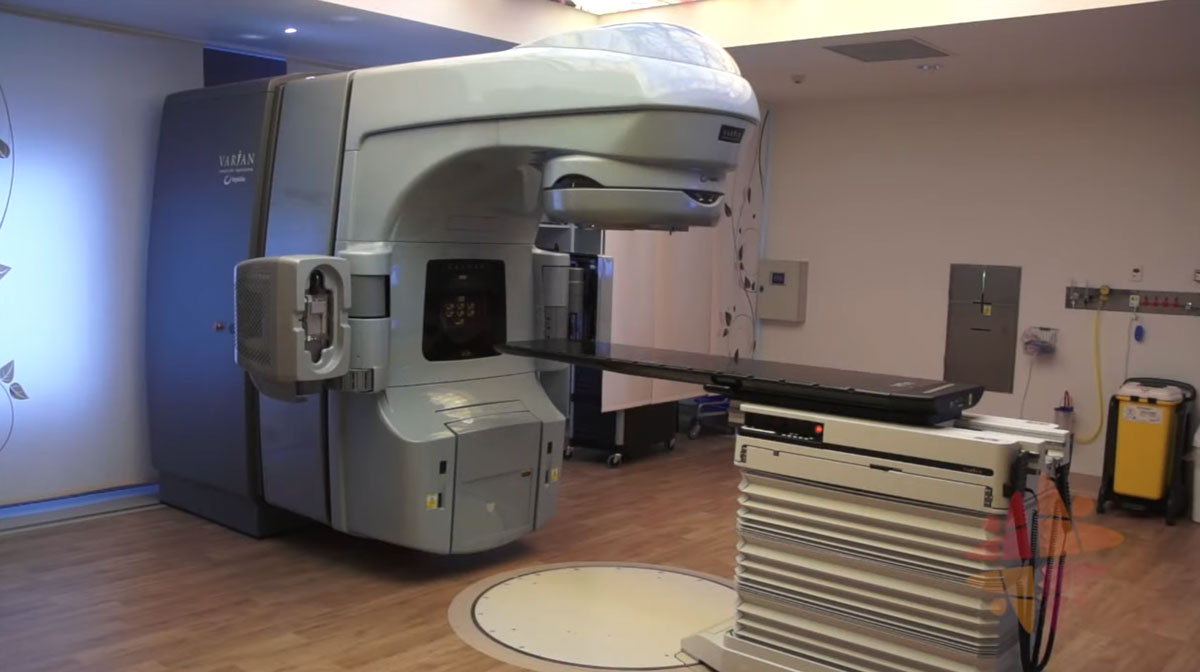Treatment Process
The External Beam Radiation Treatment process is made up of three stages:
1. Patient Planning Session
Planning session is also called a mock-up or simulation session.
A patient will come to the radiation oncology department for their planning session.
They will usually have a specialised CT scan. This scan is used to design their personalised radiation therapy treatment plan. This involves lying on a treatment bed, in the same position as they will receive treatment.
The area to be treated needs to be seen, so the patient may be asked to undress and put on a hospital gown. Special instructions, for example, no eating or an empty bladder may be needed for this appointment.
A drip may need to be inserted into a vein, usually in the arm, for dye to help see the cancer and healthy tissues on the CT scan images.
A personalised mask may need to be fitted if radiation treatment is to be given to the head and neck region.

Targeting Cancer Julie’s Story- The Making of the Immobilisation Mask
Other special equipment (for example a neck or knee rest, or personalised body cradle) are made to help the patient stay in the same position for each treatment.
Small tattoo dots (no bigger than 1mm) may be put on the patient’s skin to help treatment accuracy. These are permanent. Newer radiation therapy machines do not need tattoo dots to help line up the patient.
Photographs and precise measurements are also taken to help replicate the patient’s position.
Once the CT scan is completed, the patient then leaves the department. The session usually takes 30 – 40 minutes. The team members present may include the radiation therapists and radiation oncologist (doctor).
2. Treatment Planning Session
The patient is not present for this stage.
The radiation oncology team uses specialised computer planning software to design a personalised radiation therapy plan for each patient based on the planning CT and other recent scans.
The radiation oncologist decides what radiation dose to use and where this dose is focussed, and which healthy tissues need to be avoided.
The radiation therapists and radiation oncology medical physicists design the radiation plan and do many safety checks to ensure accuracy and safety for the patient.
This process can be complex and may take a few days or even up to a week.
3. Radiation Treatment Delivery
A patient will come to the radiation oncology department for their treatment sessions.
They will be taken to an area to get ready, change into a hospital gown as was done at their first planning session.
The patient is taken into the radiation treatment room and lies on the treatment bed, in the same position as the planning scan.
The same personalised mask (if needed) and other equipment are used to help the patient stay in the same position.
The radiation therapists perform many safety checks with lasers and measurements before treatment starts.
The radiation treatment does not hurt, and patients cannot feel it going in or working. It is a bit like having an x-ray or a CT scan.
The machine makes a whirring noise and may move around the person while they lie on the treatment bed.
There is no smell. The patient will not be radioactive after external beam radiation therapy. They are safe to be near pregnant women, children and pets.
Once the treatment is finished, the patient will be helped off the treatment bed, and taken to a changeroom to get dressed.
About 20-30 minutes is usually booked for each treatment, but some treatments (for example Stereotactic Radiosurgery (SRS) may take longer.
Other appointments may be booked for the same day (nursing, radiation oncologist, dietitian etc), otherwise the patient will usually be able to go straight home after getting dressed.
Watch this video to learn what happens when you have radiation therapy.
In the video below you will see what the machine looks like, how it moves and sounds and what the radiation oncology team do during treatment.
Remember, you won’t feel anything during treatment, it’s just like having an x-ray or scan.

Radiation Therapy Treatment Process
- Benefits and Effectiveness
- Treatment Process
- Radiation Oncology Team
- Potential Side Effects
- Indigenous and Maori Care
- Frequently Asked Questions
- Other Useful Resources
- External Beam Radiation Therapy (EBRT)
- Brachytherapy
- Stereotactic Radiosurgery (SRS)
- Stereotactic Ablative Radiotherapy (SABR)
- Superficial Radiation Therapy (SXRT)
- Particle Therapy
- Benefits and Effectiveness
- Treatment Process
- Radiation Oncology Team
- Potential Side Effects
- Indigenous and Maori Care
- Frequently Asked Questions
- Other Useful Resources
- External Beam Radiation Therapy (EBRT)
- Brachytherapy
- Stereotactic Radiosurgery (SRS)
- Stereotactic Ablative Radiotherapy (SABR)
- Superficial Radiation Therapy (SXRT)
- Particle Therapy
Radiation Oncologist
The best person to talk to is a radiation oncologist. You can ask your doctor for a referral to find out if radiation treatment is right for you.
GPs and Health Professionals
Information for any health professional involved in a patient's cancer care with a particular focus on primary care providers.
Talking to Your Doctor
Your GP or other doctors in the cancer team can organise a referral to a radiation oncologist.
Treatment Centres
Search and find your closest Radiation Oncology Treatment Centre.




